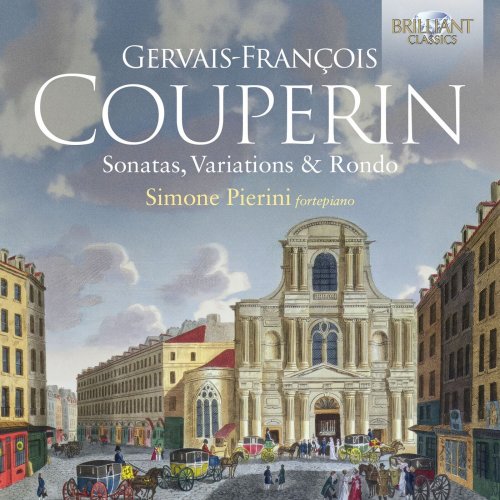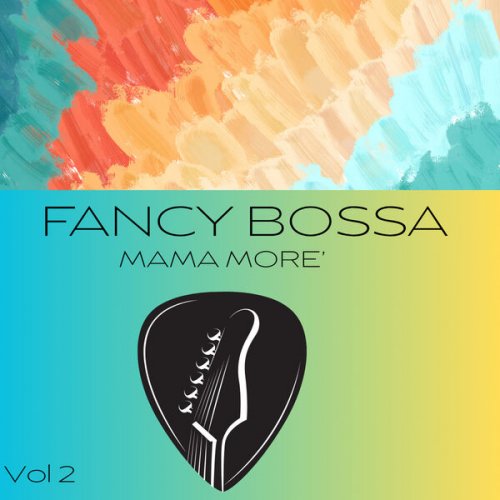Simone El Oufir Pierini - G.F. Couperin: Sonatas, Variations & Rondo (2024)

Artist: Simone El Oufir Pierini
Title: G.F. Couperin: Sonatas, Variations & Rondo
Year Of Release: 2024
Label: Brilliant Classics
Genre: Classical
Quality: flac lossless (tracks) +Booklet
Total Time: 01:11:58
Total Size: 313 MB
WebSite: Album Preview
TracklistTitle: G.F. Couperin: Sonatas, Variations & Rondo
Year Of Release: 2024
Label: Brilliant Classics
Genre: Classical
Quality: flac lossless (tracks) +Booklet
Total Time: 01:11:58
Total Size: 313 MB
WebSite: Album Preview
01. Les incroyables in G Major, Op. 6
02. Variations sur l'air "ah! Ça ira"
03. Les merveilleuses in D Major, Op. 7
04. Rondo in D Major
05. Sonata No. 1 in C Major, Op. 1: I. Allegro assai
06. Sonata No. 1 in C Major, Op. 1: II. Andante
07. Sonata No. 1 in C Major, Op. 1: III. Rondo. Presto
08. Sonata No. 2 in D Major, Op. 1: I. Allegro
09. Sonata No. 2 in D Major, Op. 1: II. Amoroso. Aria con (7) variazione
10. Sonata No. 2 in D Major, Op. 1: III. Presto
11. Variations on the "Complainte Béarnoise" in G Major
This first recording of a selection of Gervais-François Couperin’s keyboard works aims to give an overview of the youngest member of the Couperin family with works that have survived to the present day. The son of Armand-Louis Couperin (1727–1789), to whom Brilliant Records has also dedicated a release featuring his complete harpsichord works (see BC 95459), G.-F. Couperin (1759–1826) is the last known musician in the line of the greatest French musical dynasty of its time. The selection of pieces presented here is meant to demonstrate his compositional exploration of the fortepiano. The four most employed forms in Couperin’s keyboard oeuvre are the variations, the sonata, the rondo, and the piece in free form. This programme features the most important examples of these four types.
The Two Sonatas Op.1, issued in 1788, were most probably intended to officially present the young composer to the French connoisseurs. They were conceived pour le clavecin ou forte-piano, with accompaniment of violin and cello ad libitum. Both sonatas consist of three movements, the first one in a large sonata form. A slower movement follows, the one in the second sonata consisting of a theme with 7 variations. A final movement in rondo form closes both sonatas. Stylistically, they are relatively close to other sonatas of the time, although they feature quasi-symphonic writing in the first movements.
The highly virtuosic style exemplified in the two Sonatas Op.1 becomes even more evident in two single pieces, strictly related to one another: Les Incroyables Op.6 and Les Merveilleuses Op.7. The two pieces refer to adherents of a fashion trend highly favoured by the aristocracy in Paris during the French Directory (1795–99). The men were called Incroyables (“incredible”) and the women Merveilleuses (“marvelous”), and they greeted the new regime with an outbreak of luxury, decadence, even silliness, perhaps as a reaction to the Terror period. The two pieces are in free form, with a ritornello in the first, shorter part. However, this form actually owes much to the rondo, which Couperin had already proved to master, both in his sonatas and in a short individual Rondo presented here, published in the Journal de Clavecin in 1782. This short and elegant piece, which may possibly be the first piece ever published by Couperin, is the closest one to the classical period, with its almost-Viennese flavour.
Two sets of variations both published in 1790, together with the slow movement of the Sonata Op.1 No.2, show Couperin’s adeptness with this genre. It is worth noting that while the first set is based on one of the most emblematic of Revolutionary songs, ‘Ah! Ça ira’, the second is based on a royalist song, the Complainte béarnoise, a troubadour’s protestations at King Louis XVI being housed in the Palais de Tuileries at the beginning of the revolution.
![Koldo Munné & 1520's Ensemble - Live at Jamboree Live Music (2025) [Hi-Res] Koldo Munné & 1520's Ensemble - Live at Jamboree Live Music (2025) [Hi-Res]](https://www.dibpic.com/uploads/posts/2025-12/1765846749_ck2b0xbsb8jna_600.jpg)

![Stille Grender, Eva Bjerga Haugen - Svart senker natten seg (2025) [Hi-Res] Stille Grender, Eva Bjerga Haugen - Svart senker natten seg (2025) [Hi-Res]](https://www.dibpic.com/uploads/posts/2025-12/1765550212_ktbxqyoaitggb_600.jpg)


![Tomasz Stańko, Tomasz Szukalski, Dave Holland & Edward Vesala - Balladyna (1976/2025) [Hi-Res] Tomasz Stańko, Tomasz Szukalski, Dave Holland & Edward Vesala - Balladyna (1976/2025) [Hi-Res]](https://www.dibpic.com/uploads/posts/2025-12/1765717548_cover.jpg)


